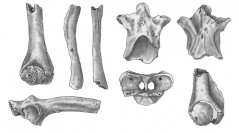

 Comptes Rendus Palevol
11 (1) - Pages 31-40
Comptes Rendus Palevol
11 (1) - Pages 31-40Herewepresent the first palaeoenvironmental and palaeoclimatic analysis based on a study of the microvertebates of the Sala de las Chimeneas (Maltravieso Cave, Cáceres). The fauna is ascribed to the end of the Late Pleistocene, as indicated by the presence of Microtus (Iberomys) cabrerae, Microtus agrestis and Arvicola terrestris and by absolute datings of ∼ 17 ka BP. The palaeoenvironmental analysis points to a setting within the early part of the Last Glacial Maximum (LGM), with a habitat dominated by woods and humid meadows, a climate (mean annual temperatures) colder than at present (−4 ◦C), and mean annual precipitation markedly higher (+700mm) than is currently the case in the area around Cáceres. These data provide new information on the impact of the last cold spells of Marine Isotope Stage 2 (MIS 2) in the Southwest of Europe, in a region where no studies of the microvertebrates of this period had previously been undertaken.
Small mammals, Herpetofauna, Palaeoenvironment, Palaeoclimate, LGM, Late Pleistocene, Spain